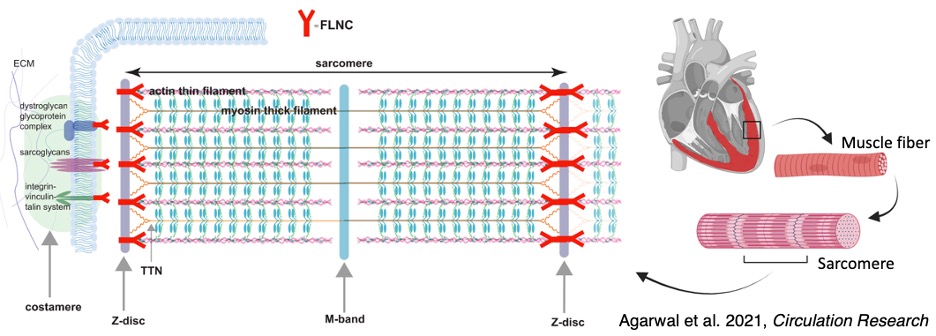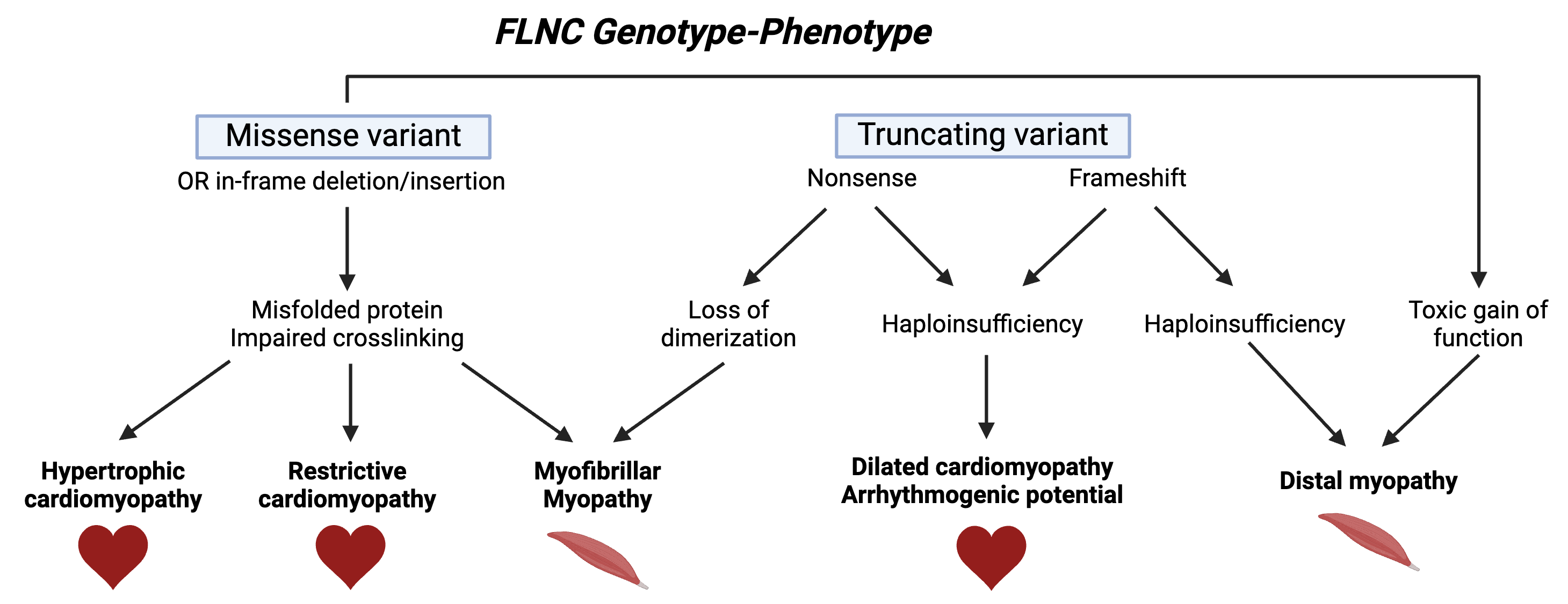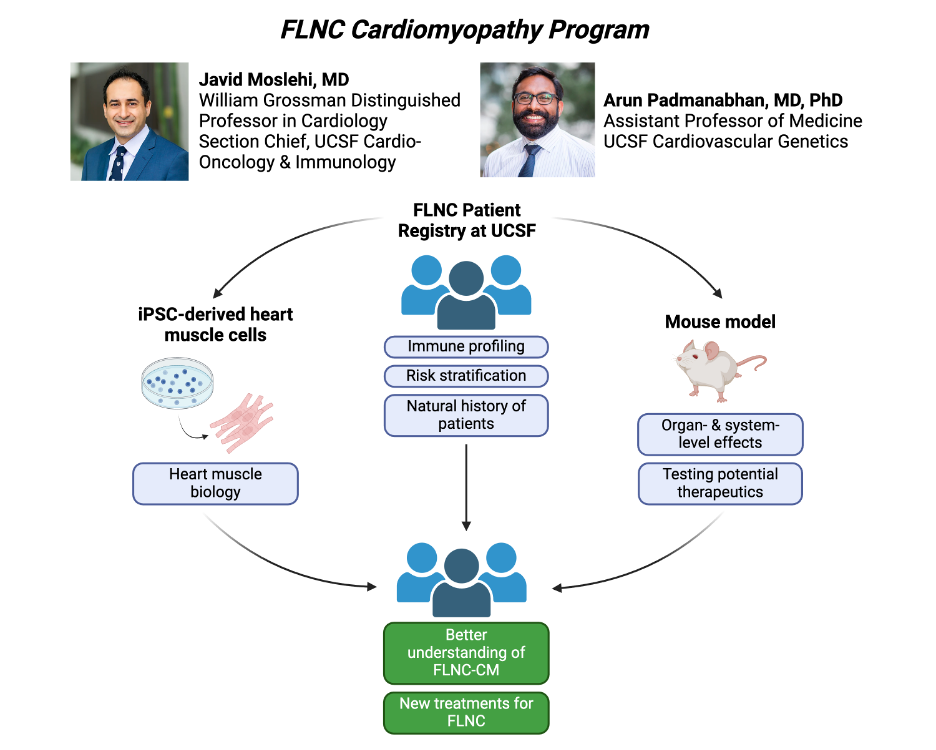Filamin C (FLNC)
Filamin C (FLNC) is a type of filamin protein that is mainly found in skeletal and heart muscle cells, and it helps maintain stability of the muscle. There are some genetic variants (or mutations) that affect the FLNC gene that encodes for filamin C. These mutations can cause abnormal filamin C proteins, which in turn can lead to dysfunction in the heart. The UCSF FLNC Cardiomyopathy program aims to better understand how FLNC variants affect the heart in patients who have these mutations.

Filamins are proteins that hold together actin filaments, which provide structure to cells. In muscles, actin filaments make up the sarcomere, which is basic functional unit of a muscle. Filamin C is a type of filamin protein that is mainly found in skeletal and heart muscle cells, and it helps maintain stability of the sarcomere.

There are some genetic variants (or mutations) that affect the FLNC gene that encodes for filamin C. FLNC mutations can include missense variants, in which a building block (i.e. amino acid) of the filamin C protein is replaced with another. With improper building blocks, the filamin C protein can become misfolded and accumulate improperly in the heart. This can lead to dysfunction in the heart, resulting in conditions such as restrictive cardiomyopathy and hypertrophic cardiomyopathy. These conditions affect the heart’s ability to pump blood properly.
Another type of FLNC variants includes nonsense variants. Truncating FLNC variants (FLNCtv) lead to the protein being shorter than normal. These abnormal proteins can cause weaker attachments between heart muscle cells, which can lead to dysfunction in the heart. Truncating FLNC variants have been associated with dilated cardiomyopathy and arrhythmogenic cardiomyopathies. In dilated cardiomyopathy, the heart is unable to contract normally and its ability to pump blood is abnormally affected. On the other hand, arrhythmogenic cardiomyopathy leads to irregular and potentially life-threatening heart rhythms.
There are also some studies that suggest FLNC (and similar sarcomere mutations) may cause inflammation in the heart. Inflammation in the heart muscle is called myocarditis, and in some cases FLNC mutations are associated with this condition. You can read more about myocarditis and our UCSF Myocarditis Center.
At UCSF, we are interested in studying the interaction between the heart and the immune system. We have a dedicated team of doctors, nurses, and research scientists in the UCSF Section of Cardio-Oncology and Immunology working on the intersection of cardiology, oncology, and immunology. You can read more about our work.
Family members
Since truncating FLNC variants are a genetic condition, family members of someone with a FLNCtv may be at risk of developing DCM, ARVC, irregular heart rhythms, inflammation in the heart, or sudden death. Close relatives (parents, siblings, and children) of someone with FLNCtv should be evaluated for the condition by consulting a cardiologist familiar with FLNCtv or through genetic testing.
UCSF Research Efforts
Unlike some other genetic mutations affecting the heart, FLNC has been more recently described. Therefore, there is increased interest to understand the disease process better. There are a number of genes that can be mutated in the heart, and each can have varied manifestations. Indeed, even within one gene (for example, FLNC), depending on the mutation the disease process can vary. For example, truncating FLNC variants (FLNCtv) are clearly different than missense variants. Even within individual FLNCtv, each mutation may be different. In addition, most of the FLNC mutations have been studied in the Caucasian population. The effects of FLNC mutations in other populations have not been thoroughly studied.
At UCSF, we are leveraging the intellectual and technical resources of various Division of Cardiology laboratories to better understand FLNC cardiomyopathies. We have developed a robust collaboration between teams in Cardiovascular Genetics, Electrophysiology and Arrhythmias, and Cardio-Oncology and Immunology.

This collaboration is taking a multi-pronged approach to studying FLNC cardiomyopathy, drawing from studies in cardiac muscle cells, mouse models, and UCSF patients. We can study how FLNC mutations affect heart muscle biology with experiments in cardiac muscle cells, such as the structure of the muscle cells and how the heart muscle responds to stretching forces. We will further this understanding with mouse models in which the mice carry FLNC mutations. Mouse experiments will also allow us to look at organ- and system-level effects, as well as the opportunity to test potential therapeutics. Finally, our proposed FLNC Patient Registry will help us gain clinical insights into the natural history of patients with FLNC mutations seen in our UCSF Cardiology clinics. Altogether, this work will contribute new knowledge about FLNC cardiomyopathy and the development of novel treatments, ultimately leading to better care for patients who have FLNC mutations.
